

Usually, the words ‘line’, ‘pennant’ or ‘pendant’ are interchangeable and describe the various ropes used in lowering and securing the sail. Actually the terminology surrounding this whole subject is vague, with different definitions describing different methods in different parts of the world. In olden days the first reef was known as the ‘slab’ and this term has rattled down over the years to describe the various methods of slab reefing. For now let’s stick with more conventional methods. We’ll deal with the in-mast variety in another article. Unfortunately, with mechanised reefing come fallibility and a host of other problems, so many offshore sailors have turned their backs on such fancy gadgetry and returned to more traditional forms of reefing. The drawing above shows a typical installation. Perhaps the method gathering the most favour these days is known as in-mast reefing and describes a system where the mainsail is drawn into a hollow mast by a rotating spar. It was slow, particularly when ‘shaking out’ the reef. Then there were rotating booms, around which a sail could be wound to achieve the same effect – roller reefing, in fact. First there were simple reef points – short rope pennants that could be used to gather up parts of a sail to reduce its area.
TACK AND CLEW FULL
To some extent, mainsail reefing has turned full circle. The purpose of this article is to help you choose which is the best for you In that aspect, the boat moves forward because the keel (centreline) of the boat acts to the water as the sail acts to the wind.There are many varieties of mainsail reefing. Sailing into the wind is possible when the sail is angled in a slightly more forward direction than the sail force.

Tacking is a sailing maneuver by which a sailing vessel, whose desired course is into the wind, turns its bow toward and through the wind so that the direction from which the wind blows changes from one side of the boat to the other, allowing progress in the desired direction. What is the term for sailing into the wind? As a noun, your tack is the course you are on relative to the wind. As a verb, to tack is to change direction by turning the bow of the boat through the wind. Heeling: This is the term for when a sailboat leans over in the water, pushed by the wind. What is it called when a boat leans to one side? Because there is often little surface wind for ships’ sails to use in this geographic location, sailing ships got stuck on its windless waters. The “doldrums” refers to the belt around the Earth near the equator. What is it called when there is no wind when sailing? The clew is the bottom back corner of the sail (furthest from the mast). The luff is the forward or leading edge of a sail. The tack (noun) is the name for the lower corner of the sail closest to the mast. You might be interested: How Much Would It Cost To Build A 1800s British Navy Style Sailing Ship? (Best solution) What is a tack and clew? It moves at an angle opposite the direction of the wind, called windward in sailing terminology. On a sailboat, wind blowing against the boat at an angle inflates the sail, and it forms a similar foil shape, creating a difference in pressure that pushes the sail perpendicular to the wind direction. The greater the departure from the straight line, the greater the “hollow” in the roach. Roach is a term also applied to square sail design -it is the arc of a circle above a straight line from clew to clew at the foot of a square sail, from which sail material is omitted. This is in reference to the nautical use of tack which refers to the direction of a boat with respect to sail position. When referring to a change in direction, position, or course of action, the correct phrase is to change tack. What does a starboard tack mean?ĭefinition of starboard tack: the tack on which the wind comes from a sailing ship’s starboard side. Both involve the processes of turning the boat to change course when the current direction of travel is no longer possible or safe. A jibe is conducted when you are heading downwind. Tacking is how you head upwind, pointing as high into the wind as possible, to keep the sails full. What is the difference between tacking and jibing?


 0 kommentar(er)
0 kommentar(er)
